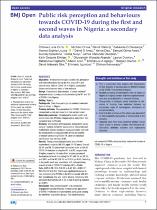| dc.contributor.author | Onoja, M | |
| dc.contributor.author | Ochu, C | |
| dc.contributor.author | Olatunji, D | |
| dc.contributor.author | Okusanya, B | |
| dc.contributor.author | Igumbor, E | |
| dc.date.accessioned | 2022-08-03T21:07:59Z | |
| dc.date.available | 2022-08-03T21:07:59Z | |
| dc.date.issued | 2022 | |
| dc.identifier.citation | : Ochu CL, Onoja M, Olatunji D, et al. Public risk perception and behaviours towards COVID-19 during the first and second waves in Nigeria: a secondary data analysis. BMJ Open 2022;12:e058747. doi:10.1136/ bmjopen-2021-058747 | en_US |
| dc.identifier.issn | 2044-6055 | |
| dc.identifier.uri | http://dx.doi.org/10.1136/ bmjopen-2021-058747 | |
| dc.identifier.uri | http://hdl.handle.net/10566/7674 | |
| dc.description.abstract | Objectives To describe changes in public risk perception
and risky behaviours during the first wave (W1) and
second wave (W2) of COVID-19 in Nigeria, associated
factors and observed trend of the outbreak.
Design A secondary data analysis of cross-sectional
telephone-based surveys conducted during the W1 and W2
of COVID-19 in Nigeria.
Setting Nigeria.
Participants Data from participants randomly selected
from all states in Nigeria.
Primary outcome Risk perception for COVID-19 infection
categorised as risk perceived and risk not perceived.
Secondary outcome Compliance to public health and
social measures (PHSMs) categorised as compliant; noncompliant and indifferent.
Analysis Comparison of frequencies during both waves
using χ2
statistic to test for associations. Univariate and
multivariate logistic regression analyses helped estimate
the unadjusted and adjusted odds of risk perception
of oneself contracting COVID-19. Level of statistical
significance was set at p<0.05.
Results Triangulated datasets had a total of 6401
respondents, majority (49.5%) aged 25–35 years. Overall,
55.4% and 56.1% perceived themselves to be at risk of
COVID-19 infection during the W1 and W2, respectively.
A higher proportion of males than females perceived
themselves to be at risk during the W1 (60.3% vs 50.3%,
p<0.001) and the W2 (58.3% vs 52.6%, p<0.05). Residing
in the south-west was associated with not perceiving
oneself at risk of COVID-19 infection (W1—AOdds
Ratio (AOR) 0.28; 95%CI 0.20 to 0.40; W2—AOR 0.71;
95%CI 0.52 to 0.97). There was significant increase in
non-compliance to PHSMs in the W2 compared with W1.
Non-compliance rate was higher among individuals who
perceived themselves not to be at risk of getting infected
(p<0.001).
Conclusion Risk communication and community
engagement geared towards increasing risk perception
of COVID-19 should be implemented, particularly among
the identified population groups. This could increase
adherence to PHSMs and potentially reduce the burden of
COVID-19 in Nigeria | en_US |
| dc.language.iso | en | en_US |
| dc.publisher | BMJ Publishing Group | en_US |
| dc.subject | Public | en_US |
| dc.subject | risk perception | en_US |
| dc.subject | behaviours | en_US |
| dc.subject | COVID-19 | en_US |
| dc.subject | the first and second waves | en_US |
| dc.subject | Nigeria | en_US |
| dc.subject | secondary data analysis | en_US |
| dc.title | Public risk perception and behaviours towards COVID-19 during the first and second waves in Nigeria: a secondary data analysis | en_US |
| dc.type | Article | en_US |

